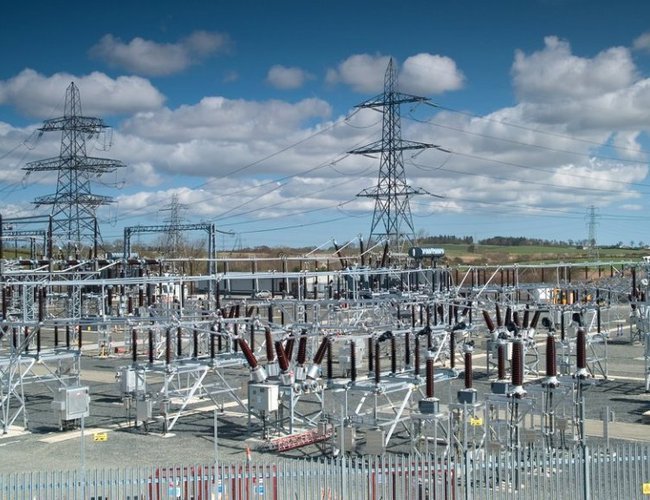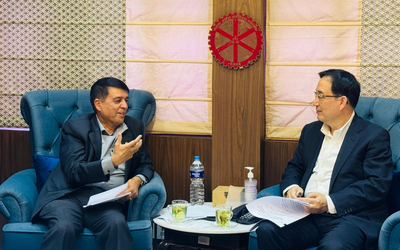
With the increase in the price of electricity in the Indian market, Nepali electricity has also started selling at the highest price there. Due to various reasons, the prices have increased due to the lack of electricity in India.
For the four month, the trade is in Nepal favor. However, it is going to shrink in coming months due to receding in the water levels and declining the production.
Nepal Electricity Authority (NEA) has exported electricity worth 12.5 billion rupees to India in the first four months of the current financial year (FY) 2080/81.
The authority has earned 12.55 billion rupees by exporting 1.36 billion 1.2 million units of electricity in July, August, October and October of the current year.
Electricity export is 4 billion 86 crore 44 lakh rupees more than the same period of last year 2079-80. In the first four months of last year, 983 million units of electricity were exported and 7 billion 63 million 64 million rupees were earned.
The authority had started selling the electricity saved in the rainy season in the Indian market from June this year. From last May to October, 1.62 billion 1.6 million units of electricity have been exported and 14.5 billion 2.1 million rupees have been earned.
Nea has exported electricity worth 2 billion 1476 million rupees in August, 3 billion 478 million rupees in August, 4 billion 1777 million rupees in October and 2 billion 697 million rupees in October. The overall average selling rate of electricity for four months is 9 rupees 18 paise per unit. The overall average sales rate for the same period last year was Rs 7.76 paise per unit.
Kulan Manghisingh, Managing Director of NEA, said that 7.84 billion Indian rupees were earned from electricity export during four months, which contributed to reducing the foreign exchange reserves of the country and the trade deficit between Nepal and India.

The authority has been exporting the electricity saved in the rainy season to India. Through competition in the day-ahead market of IX and according to the mid-term electricity agreement, NEA is selling about 110 megawatts of electricity to the Indian company NTPC Electricity Trade Corporation Ltd. Selling.
The Central Electricity Authority of India has also allowed the sale of 44 MW of electricity in the real time market in the first phase out of the 522 MW approved for export to the competitive market through NTPCVidyutVyapar Nigam Ltd-NVVN.
NEA has received approval for the export of 632 MW of 522 MW and 110 MW to NVVN in the competitive market. Out of this, 562 MW of electricity is being exported from the Dhalkebar-Muzaffar 400 kV international transmission line and 70 megawatts from the Mahendranagar-Tanakpur 132 kV transmission line.
Nepal Electricity Authority has been buying and selling electricity at competitive rates in the day-ahead market of the Indian Energy Exchange (IEX) since November 2018. Since this October, IEX has also started selling electricity at a competitive rate in the real time market.
The Indian government has set a maximum limit of Rs. 10 IC (16 Nepalese Rupees) per unit for buying and selling electricity there. Since last Tuesday, the authority has been selling electricity at the same price in both markets.
Earlier, there was a limit of 20 baht per unit for buying and selling electricity in the Indian market. Two years ago, that limit was reduced to IC Rs. 12 per unit.
Last year, the limit was Rs 10 per unit. Kulman Ghising, Managing Director of NEA, informed that electricity is currently being exported at the same rate. According to him, electricity is being bought and sold at an average price of IC Rs. 10 in IEX recently.
However, now electricity is being exported at an average of 16 rupees, Ghising says that this has also helped to increase the income generated through electricity export.
Higher price than Nepali market
Currently, the average selling price of electricity in the Nepalese market is Rs 10 per unit. According to that, it seems that the authority has got Rs 6 (per unit) more from India than the price it gets by selling in Nepal. On top of that, the electricity authority sets a lower electricity purchase rate from private producers.
At that time, the authority bought electricity from the projects at 4 rupees 80 paise per unit. According to that, it seems that the authority will get high profit if electricity is exported at the rate of 16 rupees per unit.
However, it is also argued that increasing domestic consumption rather than exporting has a positive impact on the economy. However, now the authority has been exporting electricity which is not being consumed in the country. In that case, the export of electricity is taken positively.
The authority claims that this will help Nepal's balance of payments. 20 crore daily income After getting higher price, the income from electricity export has also increased. Ghisingh, executive director of the authority, said that the daily income from electricity export is up to 20 million rupees. Now that the price is higher, the income from electricity export has also increased.
Daily income is up to 20 million rupees," he said. "This will greatly help the authority's income." Currently, the authority is exporting up to 632 megawatts of electricity to India on a day-head basis and in real time.
Electricity export of five and a half billion in two months
The authority has increased the electricity export to India by 23.15 percent in the current year 080/81. The data obtained from the Nepal Electricity Authority up to the end of the current year shows this.
In two months of the last fiscal year 079/80, electricity worth Rs.4 billion 41.5 million was exported to India. Electricity worth five billion 42 crore 31 lakh rupees has been exported in July and August of the current year. Electricity worth 1.94 billion 84 million rupees in July and 3.48 billion 48 million rupees in August has been exported to the Indian market.

The authority has set a target of exporting electricity worth around 13 to 15 billion to India this year.
Executive Director Ghising says that electricity export is contributing to Nepal's foreign exchange reserves and reducing the trade deficit between the two countries. The Authority has been exporting to India the electricity saved during the rainy season after consumption within the country.
Most of the hydropower projects in Nepal are based on run-of-river (ROR). In that case, as there is more water in the river during the dry season, the production is at full capacity. At this time, electricity can also be exported to India.
The installed capacity of electricity in Nepal is around 2900 MW. However, the domestic demand is only around two thousand megawatts. In that case, the authority can export power during dry season. However, when there is less water in the river in winter, the production is less than the domestic demand.
At that time, electricity had to be imported from India to meet domestic demand. Executive Director Ghising says that electricity can be exported for two more months. After that, electricity will be imported from India, he said.
Indian market is considered very big for Nepali electricity. As much electricity is being produced in Nepal, there is no market to consume the same amount of electricity here. Even now, Nepal is wasting electricity. Therefore, the Indian market is indispensable for Nepali electricity.
Also, due to the increasing climate change, India also needs Nepal's clean electricity. Because, running diesel and power plants in India has badly affected the environment. Due to this, there is pressure on India to increase the use of clean energy. In 2014, an agreement was reached between Nepal and India to cooperate in energy.
During the visit of Prime Minister Pushpa Kamal Dahal 'Prachanda' to India, a bilateral long-term electricity trade agreement was also signed on May 18.
Under that, Indian Prime Minister Narendra Modi also announced that India will buy 10,000 megawatts of electricity from Nepal in the next 10 years. After the draft of the final agreement was approved by the Indian Council of Ministers, the energy secretaries of both countries are preparing to sign it.
Why is there a shortage of electricity in India?
India has been facing energy crisis many times before. This year too there is a shortage of electricity in India due to various reasons.
The main sources of electricity in India are coal and diesel power plants. Now imported coal is becoming more expensive in India, which has affected India's electricity production. Similarly, a few days ago, the Teesta Dam in Sikkim burst into flood and swept away the 1200 MW Teesta-3 hydropower project. Since then, there has been a problem in India's electricity supply.
According to Prabal Adhikari, head of the trade department of the authority, the supply of electricity in India has not been able to meet the demand. Because of that, the price of electricity is increasing in the Indian market.
- MELAMCHI WATER SUPPLY: No Interruption During Monsoon
- Jun 25, 2025
- KOREAN RETURNEES: Successful Integration
- Jun 25, 2025
- UPPER TRISHULI-1: Engaging With Local
- Jun 25, 2025
- IME GROUP: Twenty Five Years Of Journey
- Jun 24, 2025
- NEPAL’S AIR POLLUTION: A Growing Health Concern
- Jun 24, 2025















